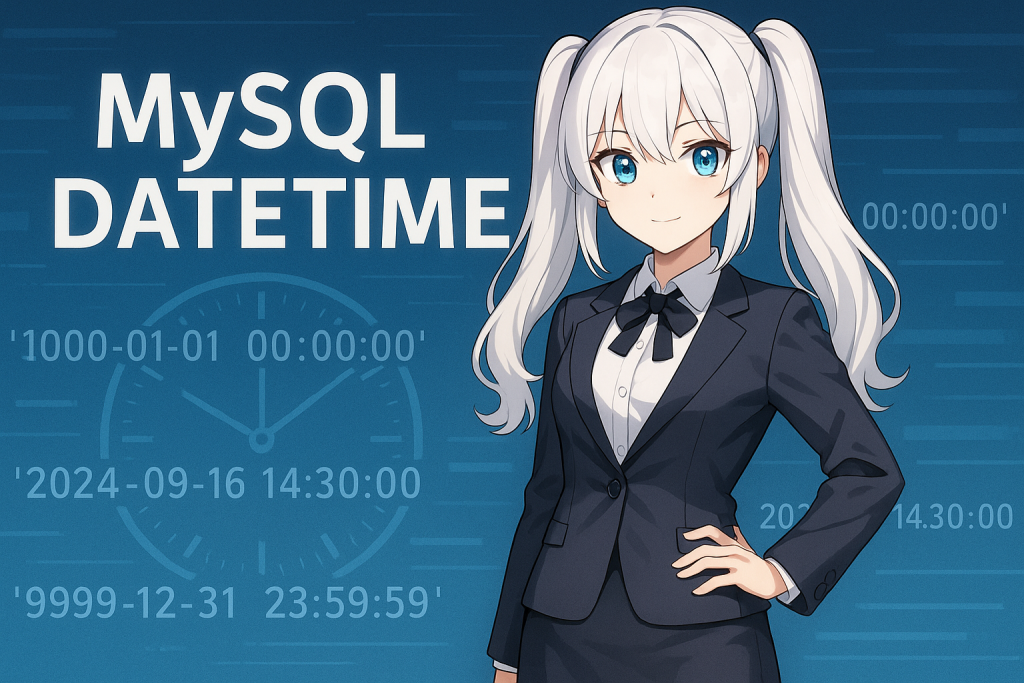1. What is MySQL’s DATETIME?
MySQL’s DATETIME is a data type designed to handle both date and time values simultaneously. Managing date and time in a database is crucial for various applications, such as logging or reservation systems. The DATETIME type stores both date and time in a single field and can hold a wide range of values, from '1000-01-01 00:00:00' to '9999-12-31 23:59:59', and also supports fractional seconds.
2. Overview of MySQL Date and Time Data Types
2.1 Data Types for Handling Dates and Times
MySQL provides the following data types for handling dates and times:
DATE: A data type for handling dates (year, month, day). The range is from'1000-01-01'to'9999-12-31'.TIME: A data type for handling only time. The range is from'-838:59:59'to'838:59:59'.DATETIME: A data type that combines both date and time. The range is from'1000-01-01 00:00:00'to'9999-12-31 23:59:59'.TIMESTAMP: A data type for storing UNIX timestamps. The range is from'1970-01-01 00:00:01'to'2038-01-19 03:14:07'.
2.2 Differences Between DATETIME and TIMESTAMP
While DATETIME and TIMESTAMP are similar, they have the following key differences:
- Time Zone:
DATETIMEstores a fixed value that is independent of the time zone. In contrast,TIMESTAMPvalues are converted to UTC upon storage and then converted back to the server’s current time zone upon retrieval. Therefore,DATETIMEis suitable for dates and times unaffected by time zones (e.g., event times), whileTIMESTAMPis more appropriate for data related to the server’s time zone, such as log records. - Storage Format:
DATETIMEis stored in its exact representation, whereasTIMESTAMPis stored as a UNIX timestamp. Consequently,TIMESTAMPis influenced by the server’s time zone settings for its time representation.
3. How to Use DATETIME in MySQL
3.1 Creating a DATETIME Column
To create a column of the DATETIME type, use the following SQL syntax:
CREATE TABLE sample_table (
event_time DATETIME
);In this example, we are creating a DATETIME column named event_time in a table called sample_table.
3.2 Inserting DATETIME Values
MySQL DATETIME values can be inserted in various formats. The basic format is 'YYYY-MM-DD HH:MM:SS'. For example:
INSERT INTO sample_table (event_time) VALUES ('2024-09-16 14:30:00');Other permitted formats include:
'YY-MM-DD HH:MM:SS': A format that specifies the year with two digits.'YYYYMMDDHHMMSS': A format that specifies values without delimiters.
Examples:
INSERT INTO sample_table (event_time) VALUES ('24-09-16 14:30:00');
INSERT INTO sample_table (event_time) VALUES (20240916143000);Data inserted in these formats will be saved correctly. If the year is specified with two digits, '70-99' will be converted to 1970-1999, and '00-69' will be converted to 2000-2069.
3.3 Retrieving DATETIME Values
When retrieving DATETIME values, MySQL displays them in the default 'YYYY-MM-DD HH:MM:SS' format. For example:
SELECT event_time FROM sample_table;This query will display the values of the DATETIME column in your table in the standard format.
4. Handling Fractional Seconds
4.1 DATETIME Precision
MySQL allows you to include fractional seconds in DATETIME values. You can specify the precision using the fsp option, which allows storing fractional seconds within a range of 0 to 6. For example, to create a column with three decimal places for fractional seconds:
CREATE TABLE precise_times (
event_time DATETIME(3)
);In this example, the event_time column can store up to three digits of fractional seconds.
4.2 Inserting Values with Fractional Seconds
To insert a DATETIME value that includes fractional seconds, use the following:
INSERT INTO precise_times (event_time) VALUES ('2024-09-16 14:30:00.123');This query accurately stores values including fractional seconds. The inserted fractional part is stored without truncation, and its precision is retained upon retrieval.

5. Best Practices for DATETIME
5.1 When to Use DATETIME vs. TIMESTAMP
- Use
DATETIMEwhen: Storing fixed dates and times that are independent of time zones (e.g., event start times, reservation dates). - Use
TIMESTAMPwhen: Storing date and time data that is related to the server’s time zone (e.g., data creation or update times).
5.2 Managing Time Zones
Since DATETIME does not have a concept of time zones, time zone management must be handled by the application. On the other hand, TIMESTAMP automatically accounts for the server’s time zone when storing and retrieving values, making it suitable for operations across different time zones worldwide.
6. Common Mistakes and How to Avoid Them
6.1 Zero Dates and Invalid Values
In MySQL, attempting to insert an invalid DATETIME value will result in a “zero date” of '0000-00-00 00:00:00' being stored. Since this is generally not a valid date, it’s crucial to validate data input to prevent the insertion of invalid values. Implementing validation to ensure input data conforms to appropriate ranges and formats can prevent the storage of zero dates.
6.2 Misuse of Precision
When specifying fractional second precision, using incorrect precision can lead to unintended results. Only specify fractional second precision when necessary, and carefully set the fsp value. For example, if your application does not require sub-second precision, there is no need to set fractional seconds for your DATETIME column.
7. Conclusion
This article provided a detailed explanation of MySQL’s DATETIME data type. DATETIME is a highly useful data type for simultaneously handling both date and time, suitable for storing values unaffected by time zones. By understanding the differences between DATETIME and TIMESTAMP, time zone handling, and the use of fractional seconds, you can effectively manage date and time data in your database. Furthermore, knowledge of common mistakes and their avoidance strategies will help maintain data consistency and reliability.
8. Frequently Asked Questions (FAQ)
Q1: What are the main differences between DATETIME and TIMESTAMP?
DATETIME stores a fixed date and time independent of time zones. For example, it’s suitable for storing reservation dates or event times that remain consistent across all time zones. In contrast, TIMESTAMP is stored based on UTC and converted to the server’s time zone upon retrieval. It’s suitable for time-sensitive data like log records that depend on the server’s time zone.
Q2: How can I store fractional seconds with DATETIME?
When creating a DATETIME column, you can set the precision for fractional seconds by specifying the fsp value. For instance, specifying DATETIME(3) allows you to store fractional seconds up to three decimal places. When inserting, use a value that includes fractional seconds, and it will be stored in the appropriate format.
Q3: Should I use DATETIME or TIMESTAMP?
It depends on your use case. Use DATETIME if you want to store a fixed date and time. On the other hand, use TIMESTAMP for date and time data that is affected by the server’s time zone, such as data creation or update times. TIMESTAMP is suitable when automatic time zone conversion is required, especially for operations across different time zones.



